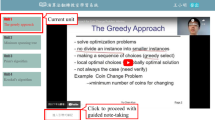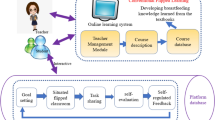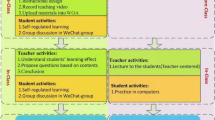Abstract
Developing students’ scientific literacy is the most important educational goal and challenge of the 21st century. Many studies have confirmed that flipped learning has significantly impacted learning science. Researchers indicate that the lack of an appropriate learning guidance strategy in the pre-class stage for flipped learning will influence students’ understanding of learning content and affect in-class learning activities. In order to tackle this problem, the present study proposed a flipped learning approach based on identification, summarization, self-reflective questioning, and application (ISSA), further exploring the influences on students’ scientific literacy, communication tendency, problem-solving tendency, learning motivation, and cognitive load. In addition, the study used a true experimental design to assess the effectiveness of the proposed learning method, and 58 university students were recruited to participate in a natural science course. The experimental group (N = 29) adopted the proposed learning approach, while the control group adopted the conventional flipped learning approach. The results showed that the experimental group had higher scientific literacy, communication tendency, problem-solving tendency, and extrinsic motivation than the control group. The interviews showed that the ISSA flipped learning method could improve students’ understanding of the learning content. In particular, the process of peer interaction promoted their self-reflection and scientific literacy skills.









Similar content being viewed by others
Data availability
The data and materials are available upon request to the corresponding author.
Code Availability
Not applicable.
References
Airasian, P. W., Cruikshank, K. A., Mayer, R. E., Pintrich, P. R., Raths, J., & Wittrock, M. C. (2001). In Anderson, & D. R. Krathwohl (Eds.), A taxonomy for learning, teaching, and assessing: A revision of Bloom’s taxonomy of educational objectives. L. W.
Ancliff, M., & Kang, A. (2017). Flipping an EMI physics class: Implications of student motivation and learning strategies for the design of course contents. International Journal of Contents, 13(4), 1–11. https://doi.org/10.5392/IJoC.2017.13.4.001.
Barnard, M., Dehon, E., Compretta, C., Notebaert, A., Sparkmon, W., Meyer, E., & Rockhold, R. (2020). Development of a competency model and tailored assessment method for high school science teachers utilizing a flipped learning approach. Educational Technology Research and Development, 68, 2595–2614. https://doi.org/10.1007/s11423-020-09782-5.
Bergmann, J., & Sams, A. (2014). Flipped learning: Gateway to student engagement. International Society for Technology in Education.
Brown, S. I., & Walter, M. I. (2014). Problem posing: Reflections and applications. Psychology Press.
Burke, A. S., & Fedorek, B. (2017). Does “flipping” promote engagement? A comparison of a traditional, online, and flipped class. Active Learning in Higher Education, 18(1), 11–24. https://doi.org/10.1177/1469787417693487.
Çakiroğlu, Ü., Güven, O., & Saylan, E. (2020). Flipping the experimentation process: Influences on science process skills. Educational Technology Research and Development, 68(6), 3425–3448.
Chen, Y., Wang, Y., & Chen, N. S. (2014). Is FLIP enough? Or should we use the FLIPPED model instead? Computers & Education, 79, 16–27. https://doi.org/10.1016/j.compedu.2014.07.004.
Cohen, J. (1988). Statistical power analysis for the behavioral sciences (2nd ed.). Erlbaum.
El Shinta, Z., Sunyono, S., & Setyorini, M. (2020). The validity of the online module of flipped classroom based on socioscientific issues towards students’ literacy skills. IOSR Journal of Research & Method in Education, 10(2), 51–56.
Galway, L. P., Corbett, K. K., Takaro, T. K., Tairyan, K., & Frank, E. (2014). A novel integration of online and flipped classroom instructional models in public health higher education. BMC medical education, 14(1), 1–9. https://doi.org/10.1186/1472-6920-14-181.
Gilboy, M. B., Heinerichs, S., & Pazzaglia, G. (2015). Enhancing student engagement using the flipped classroom. Journal of nutrition education and behavior, 47(1), 109–114. https://doi.org/10.1016/j.jneb.2014.08.008.
González-Gómez, D., Jeong, J. S., & Rodríguez, D. A. (2016). Performance and perception in the flipped learning model: An initial approach to evaluate the effectiveness of a new teaching methodology in a general science classroom. Journal of Science Education and Technology, 25(3), 450–459. https://doi.org/10.1007/s10956-016-9605-9.
Heo, H. J., & Chun, B. A. (2016). A study on the effects of mobile-based LMS on flipped learning: Focused on the affective pathway in pre‐service teacher education. International Journal of Software Engineering and Its Applications, 10(12), 473–484. https://doi.org/10.14257/ijseia.2016.10.12.39.
Hsia, L. H., & Sung, H. Y. (2020). Effects of a mobile technology-supported peer assessment approach on students’ learning motivation and perceptions in a college flipped dance class. International Journal of Mobile Learning and Organisation, 14(1), 99–113. https://doi.org/10.1504/IJMLO.2020.103892.
Huang, Y. M., & Huang, Y. M. (2015). A scaffolding strategy to develop handheld sensor-based vocabulary games for improving students’ learning motivation and performance. Educational Technology Research and Development, 63(5), 691–708. https://doi.org/10.1007/s11423-015-9382-9.
Huang, C. K., & Lin, C. Y. (2017). Flipping business education: Transformative use of team-based learning in human resource management classrooms. Journal of Educational Technology & Society, 20(1), 323–336.
Hwang, G. J., Yang, T. C., Tsai, C. C., & Yang, S. J. H. (2009). A context-aware ubiquitous learning environment for conducting complex science experiments. Computers & Education, 53(2), 402–413. https://doi.org/10.1016/j.compedu.2009.02.016.
Hwang, G. J., Yang, L. H., & Wang, S. Y. (2013). A concept map-embedded educational computer game for improving students’ learning performance in natural science courses. Computers & Education, 69, 121–130. https://doi.org/10.1016/j.compedu.2013.07.008.
Jdaitawi, M. (2020). Does flipped learning promote positive emotions in science education? A comparison between traditional and flipped classroom approaches. Electronic Journal of e-Learning, 18(6), 516–524. https://doi.org/10.34190/JEL.18.6.004.
Jeong, J. S., & González-Gómez, D. (2018). The study of flipped-classroom for pre-service science teachers. Education Sciences, 8(4), 163. https://doi.org/10.3390/educsci8040163.
Jeong, J. S., González-Gómez, D., Gallego-Picó, A., & Bravo, J. C. (2019). Effects of active learning methodologies on the students’ emotions, self-efficacy beliefs and learning outcomes in a science distance learning course. JOTSE: Journal of Technology and Science Education, 9(2), 217–227. https://doi.org/10.3926/jotse.530.
Kim, B. (2001). Social constructivism. Emerging perspectives on learning teaching and technology, 1(1), 16.
Kim, M. K., Kim, S. M., Khera, O., & Getman, J. (2014). The experience of three flipped classrooms in an urban university: An exploration of design principles. The Internet and Higher Education, 22, 37–50. https://doi.org/10.1016/j.iheduc.2014.04.003.
King, A. (1992). Comparison of self-questioning, summarizing, and notetaking-review as strategies for learning from lectures. American Educational Research Journal, 29(2), 303–323. https://doi.org/10.3102/00028312029002303.
King, J. R., Biggs, S., & Lipsky, S. (1984). Students self-questioning and summarizing as reading study strategies. Journal of Reading Behavior, 16(3), 205–218. https://doi.org/10.1080/10862968409547516.
Kirch, C. (2016). Flipping with Kirch: The ups and downs from inside my flipped classroom. The Bretzmann Group.
Kong, S. C. (2014). Developing information literacy and critical thinking skills through domain knowledge learning in digital classrooms: An experience of practicing flipped classroom strategy. Computers & Education, 78, 160–173. https://doi.org/10.1016/j.compedu.2014.05.009.
Lai, C. L., & Hwang, G. J. (2014). Effects of mobile learning time on students’ conception of collaboration, communication, complex problem-solving, meta-cognitive awareness and creativity. International Journal of Mobile Learning and Organisation, 8(3), 276–291. https://doi.org/10.1504/IJMLO.2014.067029.
Lee, J., & Choi, H. (2019). Rethinking the flipped learning pre-class: Its influence on the success of flipped learning and related factors. British Journal of Educational Technology, 50(2), 934–945.
Lee, M. K., Chang, S. J., & Jang, S. J. (2017). Effects of the flipped classroom approach on the psychiatric nursing practicum course. Journal of Korean Academy of Psychiatric and Mental Health Nursing, 26(2), 196–203. https://doi.org/10.12934/jkpmhn.2017.26.2.196.
Li, Y. L., Li, M. J., & Yang, F. (2019). Teaching method design in engineering bidding course based on integration of problem chain and mind map. Advances in Social Science Education and Humanities Research, 403, 17–23. https://doi.org/10.2991/assehr.k.200207.004.
Lin, Y. N., & Hsia, L. H. (2019). From social interactions to strategy and skills promotion: An ASQI-based mobile flipped billiards training approach to improving students’ learning engagement, performance and perceptions. Educational Technology & Society, 22(2), 71–85.
Lin, H. C., Hwang, G. J., & Hsu, Y. D. (2019). Effects of ASQ-based flipped learning on nurse practitioner learners’ nursing skills, learning achievement and learning perceptions. Computers & Education, 139, 207–221. https://doi.org/10.1016/j.compedu.2019.05.014.
Lin, Y. N., Hsia, L. H., & Hwang, G. J. (2021). Promoting pre-class guidance and in-class reflection: A SQIRC-based mobile flipped learning approach to promoting students’ billiards skills, strategies, motivation and self-efficacy. Computers & Education, 160, 104035. https://doi.org/10.1016/j.compedu.2020.104035.
Lo, C. K., Lie, C. W., & Hew, K. F. (2018). Applying “First Principles of Instruction” as a design theory of the flipped classroom: Findings from a collective study of four secondary school subjects. Computers & Education, 118, 150–165. https://doi.org/10.1016/j.compedu.2017.12.003.
Loveys, B. R., & Riggs, K. M. (2019). Flipping the laboratory: Improving student engagement and learning outcomes in second year science courses. International Journal of Science Education, 41(1), 64–79. https://doi.org/10.1080/09500693.2018.1533663.
Mayer, R. E. (2014). Incorporating motivation into multimedia learning. Learning and Instruction, 29, 171–173. https://doi.org/10.1016/j.learninstruc.2013.04.003.
Monaghan-Geernaert, P. (2019). Flipping the classroom to teach the evaluation of research articles and the development of scientific literacy. Journal of Instructional Research, 8(1), 62–70. https://doi.org/10.9743/JIR.2019.1.6.
Montgomery, A. P., Mousavi, A., Carbonaro, M., Hayward, D. V., & Dunn, W. (2019). Using learning analytics to explore self-regulated learning in flipped blended learning music teacher education. British Journal of Educational Technology, 50(1), 114–127. https://doi.org/10.1111/bjet.12590.
Moraros, J., Islam, A., Yu, S., Banow, R., & Schindelka, B. (2015). Flipping for success: Evaluating the effectiveness of a novel teaching approach in a graduate level setting. BMC medical education, 15(1), 27. https://doi.org/10.1186/s12909-015-0317-2.
Moses, B., Bjork, E., & Goldenberg, E. P. (1990). Beyond problem solving: Problem posing. In T. J. Cooney (Ed.), Teaching and learning mathematics in the 1990s (82–91). Reston, VA: National Council of Teachers of Mathematics.
O’Flaherty, J., & Phillips, C. (2015). The use of flipped classrooms in higher education: A scoping review. The internet and higher education, 25, 85–95. https://doi.org/10.1016/j.iheduc.2015.02.002.
OECD. (2007). PISA 2006: Science competencies for tomorrow’s world. OECD.
Paristiowati, M. (2019). Hybrid of chemistry learning activities in secondary school through development of the flipped classroom model. Asia Proceedings of Social Sciences, 4(3), 11–13. https://doi.org/10.31580/apss.v4i3.810.
Pintrich, P. R., Smith, D. A. F., Garcia, T., & McKeachie, W.J. (1991). A manual for the use of the motivated strategies for learning questionnaire (MSLQ). MI: National Center for Research to Improve Postsecondary Teaching and Learning.
Sargent, J., & Casey, A. (2020). Flipped learning, pedagogy and digital technology: Establishing consistent practice to optimise lesson time. European physical education review, 26(1), 70–84. https://doi.org/10.1177/1356336X19826603.
Shih, W. L., & Tsai, C. Y. (2017). Students’ perception of a flipped classroom approach to facilitating online project-based learning in marketing research courses. Australasian Journal of Educational Technology, 33(5), https://doi.org/10.14742/ajet.2884.
Soliman, N. A. (2016). Teaching English for academic purposes via the flipped learning approach. Procedia-Social and Behavioral Sciences, 232, 122–129. https://doi.org/10.1016/j.sbspro.2016.10.036.
Srisuwan, C., & Panjaburee, P. (2020). Implementation of flipped classroom with personalised ubiquitous learning support system to promote the university student performance of information literacy. International Journal of Mobile Learning and Organisation, 14(3), 398–424. https://doi.org/10.1504/IJMLO.2020.108200.
Stratton, E., Chitiyo, G., Mathende, A. M., & Davis, K. M. (2019). Evaluating flipped versus face-to-face classrooms in middle school on science achievement and student perceptions. Contemporary Educational Technology, 11(1), 131–142. https://doi.org/10.30935/cet.646888.
Trenshaw, K. F., Revelo, R. A., Earl, K. A., & Herman, G. L. (2016). Using self-determination theory principles to promote engineering students’ intrinsic motivation to learn. International Journal of Engineering Education, 32(3), 1194–1207.
Tsai, C. C. (2004). Beyond cognitive and metacognitive tools: The use of the internet as an ‘epistemological’ tool for instruction. British Journal of Educational Technology, 35(5), 525–536. https://doi.org/10.1111/j.0007-1013.2004.00411.x.
Turan, Z., & Goktas, Y. (2016). The flipped Classroom: Instructional efficiency and impact of achievement and cognitive load levels. Journal of e-learning and knowledge Society, 12(4).
Wang, L. C., & Chen, M. P. (2010). The effects of game strategy and preference-matching on flow experience and programming performance in game‐based learning. Innovations in Education and Teaching International, 47(1), 39–52. https://doi.org/10.1080/14703290903525838.
Yazici, B., & Yolacan, S. (2007). A comparison of various tests of normality. Journal of Statistical Computation and Simulation, 77(2), 175–183. https://doi.org/10.1080/10629360600678310.
Ye, X. D., Chang, Y. H., & Lai, C. L. (2019). An interactive problem-posing guiding approach to bridging and facilitating pre-and in-class learning for flipped classrooms. Interactive Learning Environments, 27(8), 1075–1092. https://doi.org/10.1080/10494820.2018.1495651.
Funding
This study is supported in part by the Ministry of Science and Technology of Taiwan under contract numbers MOST 111-2410-H-011 -007 -MY3 and MOST 111-2410-H-142-013.
Author information
Authors and Affiliations
Contributions
All authors contributed to the study conception and design. Material preparation, data collection and analysis were performed by Shu-Chen Cheng and Chih-Hung Chen. Project administration were performed by Shu-Chen Cheng and Chih-Hung Chen. Methodology and supervision were performed Gwo-Jen Hwang and Chih-Hung Chen. The first draft of the manuscript was written by Shu-Chen Cheng and Chih-Hung Chen. All authors commented on previous versions of the manuscript. All authors read and approved the final manuscript.
Corresponding author
Ethics declarations
Conflicts of interest/Competing interests
There is no potential conflict of interest in this study.
Ethics approval
The ethical requirements for research in this selected university were followed.
Consent to participate
The participants all agreed to take part in this study.
Consent for publication
The publication of this study has been approved by all authors.
Additional information
Publisher’s Note
Springer Nature remains neutral with regard to jurisdictional claims in published maps and institutional affiliations.
Rights and permissions
Springer Nature or its licensor (e.g. a society or other partner) holds exclusive rights to this article under a publishing agreement with the author(s) or other rightsholder(s); author self-archiving of the accepted manuscript version of this article is solely governed by the terms of such publishing agreement and applicable law.
About this article
Cite this article
Cheng, SC., Hwang, GJ. & Chen, CH. Fostering students’ scientific literacy by reflective questioning: An identification, summarization, self-reflective questioning, and application (ISSA)-based flipped learning approach. Educ Inf Technol 29, 7081–7104 (2024). https://doi.org/10.1007/s10639-023-12121-9
Received:
Accepted:
Published:
Issue Date:
DOI: https://doi.org/10.1007/s10639-023-12121-9




